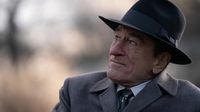Robert De Niro returns to the big screen in "The Alto Knights," taking on the challenging role of both notorious mobsters Frank Costello and Vito Genovese in a film that explores their complex relationship set against the gritty backdrop of 1950s New York. Directed by Barry Levinson and written by screenwriter Nicholas Pileggi, who both are well-known for their past work in the gangster genre, the film debuted in theaters on March 21, 2025.
The narrative kicks off with a dramatic scene in which Frank is shot in the lobby of his New York apartment building. While he survives this assassination attempt—ordered by Genovese, who feels threatened by Frank’s status—what follows is a surprisingly hasty flashback to their shared past as childhood friends turned rivals, cemented by their interactions at the Alto Knight Social Club.
During a period of Prohibition, both Frank and Vito rise through the ranks of the Luciano crime family, yet their strong bond deteriorates once Vito flees to Italy to dodge a murder charged, allowing Frank to ascend to power in his absence. Upon Vito's return to the U.S., their relationship becomes fraught with jealousy and competition, culminating in significant events such as the 1957 mob summit in upstate New York, which was raided by law enforcement.
Critics have had mixed reactions to "The Alto Knights," praising De Niro's performances but lamenting the film's lack of originality. While De Niro adeptly embodies both characters—the stoic Costello and the volatile Genovese—there seems to be a fundamental question lingering: does having an actor portray both parts elevate the narrative or distract from it? This duality of performance appears to serve primarily as a gimmick rather than a thematic exploration of the intertwined fates of its leading characters.
According to reviews, the film does not shy away from the typical tropes of mob movies, checking off all the cliches while failing to bring anything new to the table. Although there are moments of excitement, including the politically charged Senate hearings on organized crime and suspenseful sequences during mob meetings that reveal the inner workings of these powerful men, the overarching script has been described as predictable and hasty. For instance, significant portions of backstory are delivered through rapid-fire montages, leading to an unbalanced pacing that may leave audiences craving more depth and connection to the characters.
Katie Walsh from Tribune News Service notes that while the film maintains a reflective quality, akin to previous De Niro projects, it emphasizes mob movie conventions instead of breaking any new ground. The film showcases De Niro’s ability to dominate the screen, though, with tense moments highlighting his character's indecision and internal conflict—not only in terms of navigating his relationship with Vito but also in his lofty ambitions of possibly going legitimate.
Another reviewer pointed out that the film could be construed as a meta-commentary, reflecting on the legacy of the gangster film itself. Indeed, several aspects of "The Alto Knights" hint at self-awareness, from its nostalgic tone to its stylistic homages to classic films. However, it appears to treasure style over substance, leaving some critics feeling that this film works better as a routine flashback of familiar themes rather than an engaging retelling of a historical rivalry.
As the story unfolds, De Niro’s dual portrayal of Costello and Genovese embodies the ideological clash between preserving traditional mob values and the modernizing, ruthless approaches pushed by Genovese—a character equal parts impulsive and volatile who seeks control of the drug trade. There are moments of tension that highlight the differences between Frank's desire for a respectable demeanor versus Vito's penchant for violence. Yet the execution remains too glossy and fast-paced, sometimes veering away from genuine character development towards a more superficial treatment of their rivalry.
While "The Alto Knights" might not reach the emotional resonance and layered complexity of earlier gangster films like "Goodfellas," it still presents a snapshot of American mob life through the lens of powerful performances and nostalgic elements. The film checks boxes for mob movie fans but struggles to break free from its own ambitions, hinging heavily on the audience's willingness to forgive its shortcomings.
Ultimately, "The Alto Knights" lends itself to enjoyment as an old-school mob film, even if it never fully realizes its potential. It occupies a space in De Niro's storied filmography: a reminder that while the genre embodies a certain glamor, it also captures the grit and turmoil of a bygone era.









